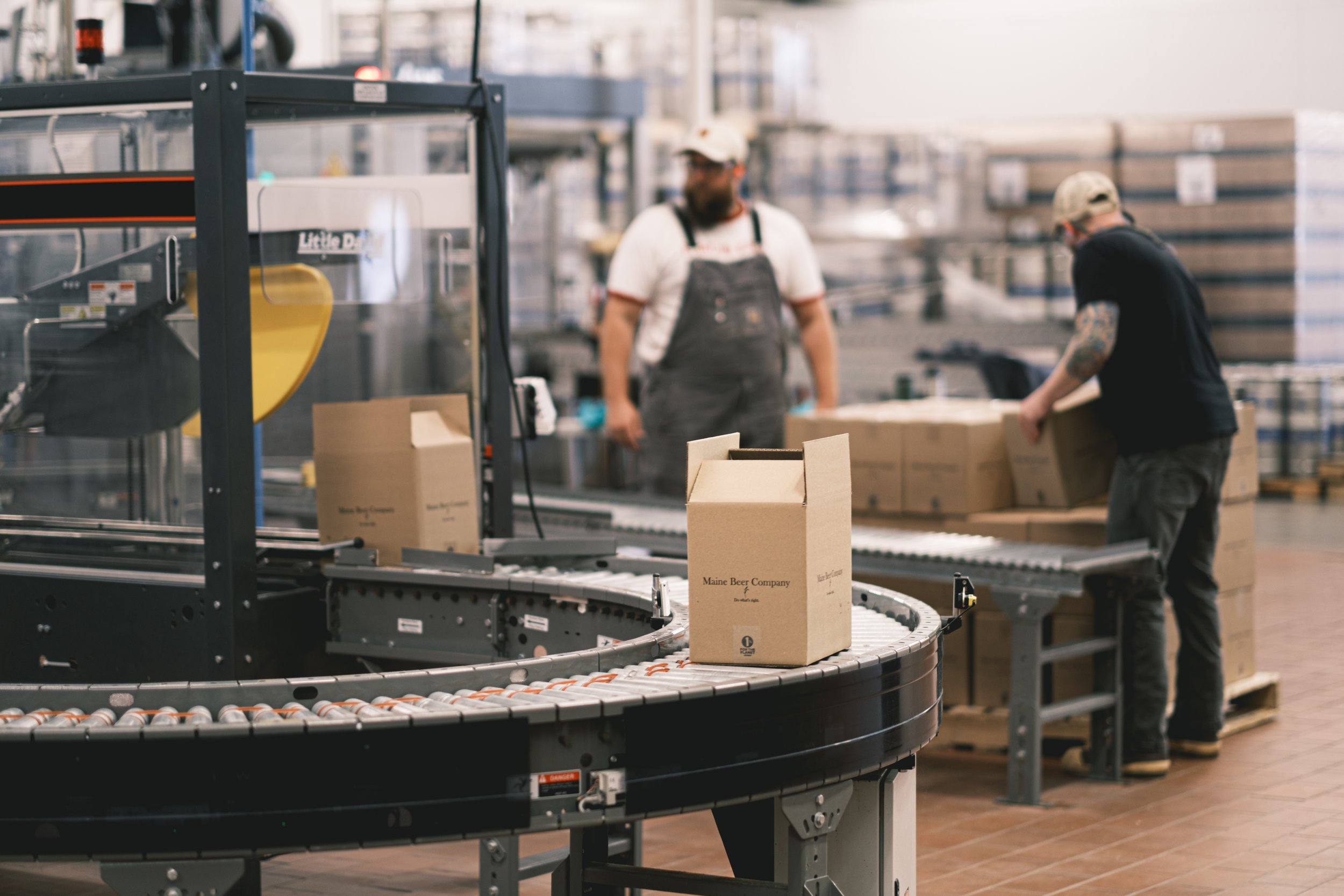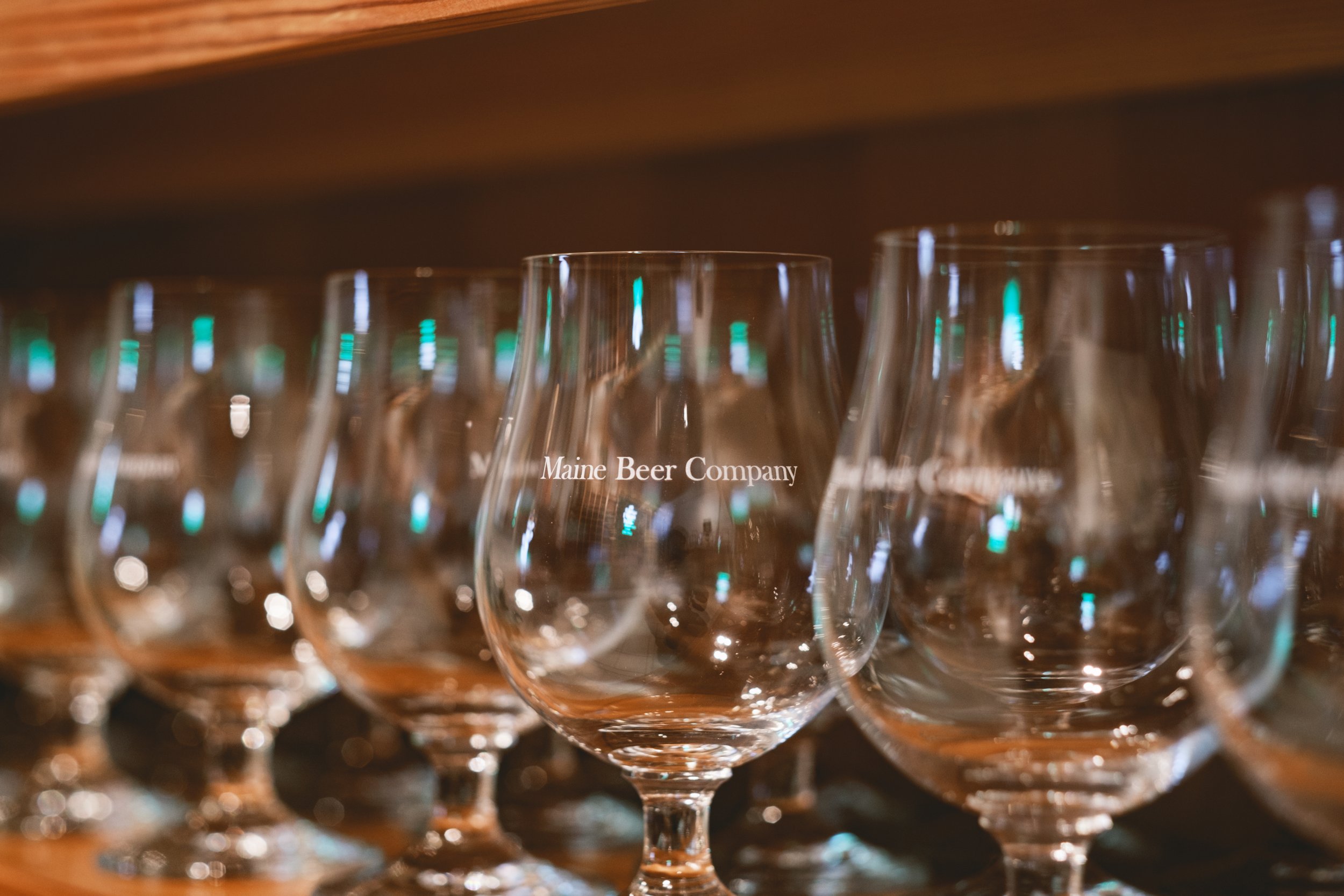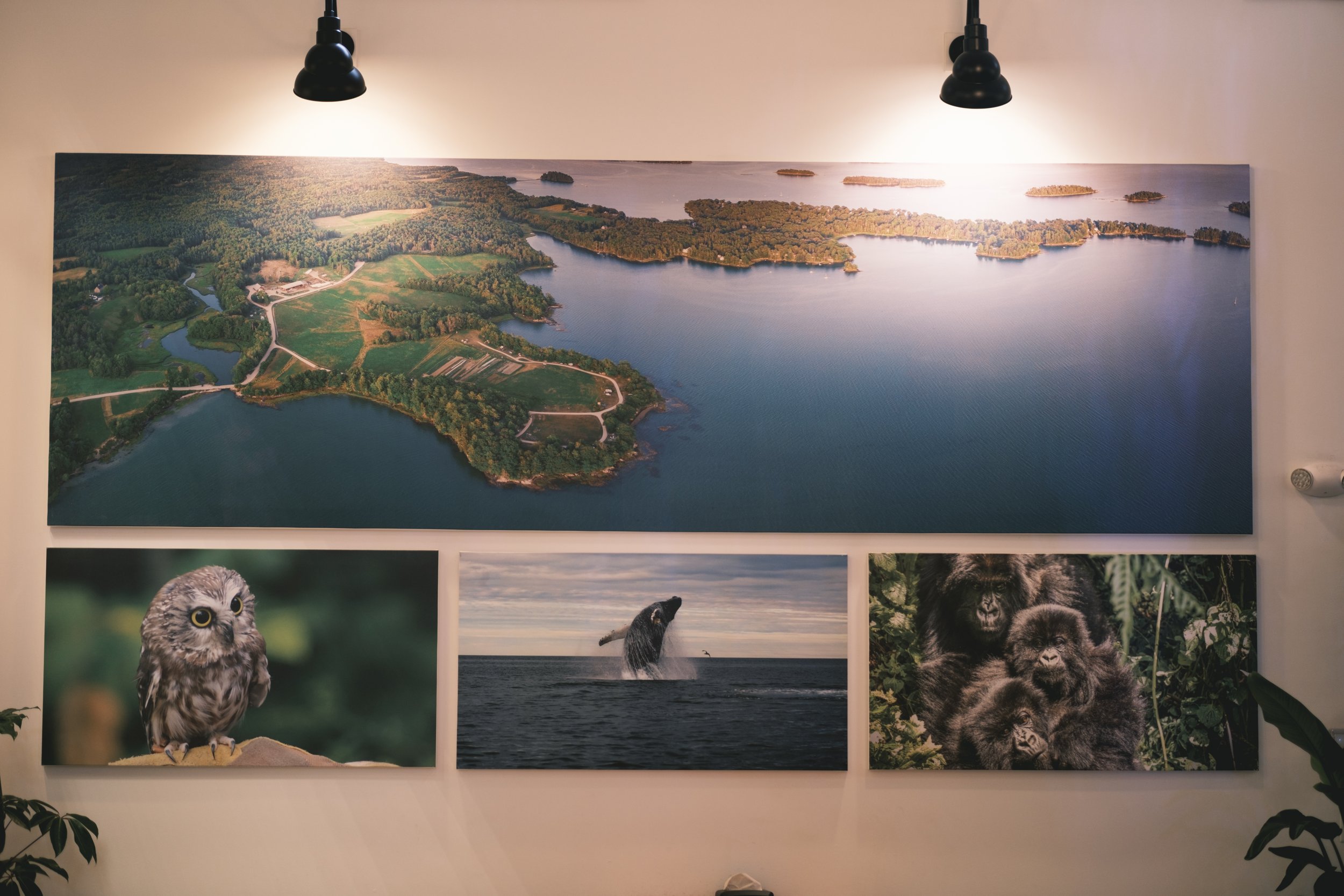Off the coast of Bar Harbor on the Gulf of Maine, marine life teems below the swelling sea. Sunfish, basking sharks, and several species of dolphins chart these waters, though the whales—right, minke, finback—are the real draw. If you stand and watch the surface long enough, you might just be rewarded with a pulse-altering glimpse of these majestic creatures.
On an autumn morning walk around Acadia National Park in 2009, David Kleban and his then-five-year-old daughter, Zoe, sheltered from the rain in the Bar Harbor Whale Museum, and took delight in learning about what inhabited the waters immediately outside. The morning is immortalized on the bottle of Zoe, an Amber Ale made by Maine Beer Company.
“Zoe loved it,” the bottle reads. “It put a smile on her face. We hope our ale will do the same for you.”
The impulse to immortalize life’s mundane—but meaningful—moments became a main driver for Dave Kleban and his brother Dan in the early days of Maine Beer Company, headquartered roughly 150 miles southwest from Bar Harbor in Freeport, Maine.
“You tend to take a longer view when you become a parent,” says Dan Kleban. “You’re no longer doing things just for you. You have this awesome responsibility. Our desire to do good wasn’t driven by some academic exercise or background in environmental science. It was really that we’re human beings and we realized things needed to change in this world. [We decided] businesses need to start behaving more responsibly if we are going to ensure that the world we grew up in and all the luxuries we have are accessible and available to our kids.”
After three grueling years in law school, Kleban found himself unemployed when the economy collapsed in the fall of 2008, leaving him at a professional standstill. Alongside his brother Dave, a financial advisor with an entrepreneurial spirit, he’d taken up homebrewing as a hobby. When Kleban began to take the hobby more seriously, Dave, ever the hustler, brought up brewing professionally.
There were two issues.
“First, my wife had just spent three years helping me get through law school,” says Kleban. “I didn’t feel great having to tell her that I wasn’t going to practice law. That would have gone over like a lead balloon. Secondly, this was 2009; there weren’t any breweries opening up at that time. It wasn’t like it is now.”
“If we’re going to do this, we have to do it right. For us, that meant only making the best beer we could, but, more importantly, we wanted to create a company we could be proud of. In light of what was going on in the world [with the recession], we saw people getting kind of the raw end of the deal. [We thought,] ‘There’s gotta be a better way to do this.’”
Nevertheless, the startling and sudden emptiness of the recession provided the clarity Kleban needed. “The economy tanked,” he remembers. “We were out of a job, so we thought, ‘Why not?’”
Armed with a small cooler, Kleban and his brother—often accompanied by Zoe—hit the Portland streets. The largest city in Maine, Portland is known now as a sort of craft beer mecca, with more breweries per capita than any other city in America. Great beer fills taplines everywhere from world-class beer bars to concert venues and dives. This was not the case in 2009 as the nascent craft brewery went to bars across the city with bottles of its flagship Pale Ale, then called Spring Peeper Ale.
“It was challenging,” Kleban says. Back then, the brewery packaged its beer in 500ml bottles, sold individually; draft hadn’t yet entered the picture. “It was a different marketplace then. It was $9.99 six-packs. When we first started shopping our beer, people looked at us like we were crazy. We had to create a new market for our beer. We always stood by the idea that if you make good beer, people will pay for it. It was a risk.”
More than just challenging the status quo, the goal was to question how businesses were being run, to change the entire discourse about what a small brewery could do for the greater good.
“If we’re going to do this, we have to do it right,” Kleban says of the brothers’ early ethos. “For us, that meant only making the best beer we could, but, more importantly, we wanted to create a company we could be proud of. In light of what was going on in the world [with the recession], we saw people getting kind of the raw end of the deal. [We thought,] ‘There’s gotta be a better way to do this.’”
That focus—the company motto, “Do What’s Right,” is now stamped all over bottles, business cards, and signage—has been a throughline throughout Maine Beer Co’s existence. But its approach to brewing is what first made it a standout.
On any given Saturday, Industrial Way in Portland is packed with beer drinkers bouncing from one brewery to the next. Five breweries now occupy the small street, the smell of food trucks’ hot griddles wafting through the air. In 2009, though, industry giant Allagash Brewing Company was the only brewery along this isolated stretch of business parks on the edge of town. The scene expanded when Maine Beer Company opened up its doors in the first building on the right, suite #1. The only sign of its presence was a small decal outside.
Spring Peeper Ale (eventually shortened to Peeper Ale), a 5.5% Pale Ale made with Centennial, Amarillo, and Cascade hops, was its only offering. Back then, it was a novelty: In 2009, the industry was in the midst of an IBU arms race, breweries looking to outgun each other with ever bigger and bolder IPAs. Tongue-scrapingly bitter, hop-forward Ales from the West Coast were in demand. East Coasters tried to keep up.
“I was looking to create a beer full of fresh American hoppy flavor and aroma but also delicate enough you could have a couple of them and your mouth wasn’t wrecked,” Kleban says. “The West Coast hoppy beers were great, but often they were coming off a truck and they weren’t at their best when we drank them. I wanted to make fresh hoppy beers here in Maine. We had the resources to do that.”
Peeper, bright and clean, was decidedly the counterpunch. It stood out because it didn’t stand out. Rumors started to trickle out that there was another Maine brewery worth visiting in Portland, and drinkers began to flock to Industrial Way. Then, a new launch drew even more attention: Lunch, the first IPA Kleban brewed outside of a homebrew scale.
“People sometimes think that we brewers are [...] these geniuses who know which beers we brew are going to be so successful that people are going to flock to them and line up outside of breweries,” he says. “Well, that’s bullshit. None of us know. We have no idea how it’s going to play in the marketplace.”
Lunch was well-balanced and less bitter than its counterparts at the time, yet still full of hop flavor and aroma. What started as a one-off release turned into a beer that resonated with drinkers. They, in turn, took to social media and beer ratings sites like RateBeer and Beer Advocate.
“All of a sudden you had this medium where people could spread the word on your behalf and there were no limitations,” Kleban says. “Before you knew it, all these people wanted to taste it. We didn’t make enough for people to drink it. We didn’t have the capacity. We were still a tiny brewery. And so for a while it was scarce out of necessity. It took us a while for the supply to catch up to demand. Once it did, it became the growth-driver for our brewery.”
And that growth helped further the company’s most urgent calling: To change existing paradigms, and work better to benefit both people and the planet.
Every year, Maine Beer Company gives 1% of its annual gross sales to environmental nonprofits. By the end of this year, the brewery will have surpassed $2 million in giving since 2009. The employees in the tasting room do not accept tips, but, according to CEO Steve Mills, “If a customer wants to leave extra money, we’ll donate it to our causes.”
Mills took the position in 2018 after stints at Boulevard Brewing Co. in Kansas City and Uinta Brewing Co. in Salt Lake City, and quickly familiarized himself with the brewery’s dogooder sensibility. Expansion was also on the cards: Mills says that when interviewing for the CEO position with the Kleban brothers, they told him that a greater regional and national footprint meant a larger opportunity to create a share for their employees and for the environment.
Most of that growth has happened within New England and the surrounding Northeast states, though the brewery is able to make occasional drops in Colorado, Wisconsin, and Texas. When Mills took the job, Maine Beer produced a little more than 19,000 barrels annually; this year, it is on track to eclipse 34,000 BBLs. This increased production “equals increased revenue and greater ability to care for our people and nonprofit partners,” says Mills.
“By 2030, all the energy we consume will come from Maine-generated clean energy,” he says. “We’re looking at CO2 recovery and water consumption. We ask ourselves all the time, ‘What can we reuse, what can we reduce?’ We look at everything from the size of our menus to what species of plants occupy our tasting room.”
As part of the business’s broader sustainability mission, employees receive full benefits, competitive salaries, and contributions to their retirements. This leads not just to lasting retention, but a happier and healthier working environment. “It’s not what it costs, it’s what it benefits,” says Mills.
Asked if there is a contradiction between wanting growth and working towards sustainability, Mills is undeterred. “Every additional dollar we make requires us to give more to nonprofits because of our commitment to 1% for the planet,” he says. “Greater profits allow us to continue to pay 100% of our employees’ health insurance, provide better wages, and invest in solar and projects like CO2 capture.”
“For plenty of people, their entry to Wolfe’s Neck is through that beer. It’s hard to quantify, but it helps. And at every event we hold on site from farm-to-table dinners or harvest dances, they provide the beer. [The partnership] absolutely makes people on both sides aware of the other.”
“Employers should be taking care of employees, they should be getting benefits, they should be provided with a living wage,” adds Kleban. Maine’s minimum wage is $12.75; a former employee confirmed that starting pay at the company was $18 an hour, but the source believed “it has gone up since then.”
The core commitment of Maine Beer Company, though, is to the environment. The brewery has partnered with nonprofits that focus on six tenets: animal protection, climate action, community support, equity and inclusion, land preservation, and outdoor access. Beers like Little Whaleboat, an IPA, bring attention to the series of small islands in Maine’s Casco Bay protected by Maine Coast Heritage Trust; Woods & Waters, another IPA, was brewed to commemorate the establishment of the Katahdin Woods and Waters National Monument.
One of the causes closest to the brewery’s heart is the Wolfe’s Neck Center for Agriculture and the Environment, which is located near the brewery and is bordered by the Harraseeket River and Casco Bay.
“It comes down to values,” says Dave Herring, executive director at Wolfe’s Neck. “Dave and Dan [Kleban] share a set of values, mainly around protecting our planet. All the decisions they’ve made and we make are really focused around that. We’ve found a ton of common ground … We’ve seen them as a business to emulate. It’s a partnership that’s hard to explain how meaningful it’s been for us.”
Aside from the beauty of the location—Wolfe’s Neck State Park, which is owned by the state of Maine—the organization is also notable for sponsoring its own environmental research. The Center for Agriculture and the Environment is committed to finding agricultural solutions to fight climate change. Regenerative agricultural practices, and experimental work substituting cows’ diets with kelp in an effort to reduce methane, are two examples of its standing on the cutting edge of agricultural innovation.
The eponymous 6.5% IPA is made with Mosaic, Sabro, and El Dorado hops, but, most importantly to Maine Beer Company, it incorporates local malts from Maine Malt House in Mapleton, Maine.
“For plenty of people, their entry to Wolfe’s Neck is through that beer,” says Herring. “It’s hard to quantify, but it helps. And at every event we hold on site from farm-to-table dinners or harvest dances, they provide the beer. [The partnership] absolutely makes people on both sides aware of the other.”
As photographer Mike Lianza and I stood at a picnic table overlooking the water, it was evident why this place means something to Maine Beer. The company and its employees don’t seem to be apart from the action—they’re a part of it, hopping into kayaks and bikes and visiting the land and animals for which they are advocating.
“Maine Beer Company has sought out partnerships with other businesses they admire and want to help,” says Herring. “Our relationship is the opposite of a transactional relationship. [These partnerships] are able to amplify each other’s work. We support each other and help amplify the messages of things we both care about.”
In 2013, Maine Beer moved north to Freeport to create a new space for more fermenters, more beer, and—finally—offices. After a slight pandemic dip from 2019 to 2020, the brewery is back on a “healthy growth trajectory,” says Mills. Its current headquarters is a beautiful white space, outfitted with sleek marble bar tops and wooden picnic tables. A fountain creates a peaceful ambiance amidst the siren call of a pizza oven and, on the day of my visit, the music of A Tribe Called Quest. Photographs of the brewery’s past, scenes from nature, and evidence of past initiatives line the wall. Stenciled across the white walls is the company motto “Do What’s Right,” and, above the retail space, simply, “Thank You.”
Clean, well-crafted, and perfectly poured hop-forward beers occupy almost every glass in a half-filled Friday morning tasting room. It’s a scene to make Mills proud of the company’s ability to remain true to its initial task. “We haven’t had to modify [our standards],” he says. “We’ve been able to be true to that clean, hop-forward beer style and consumers will give us that nod. We’re not going to chase. We’re just going to keep doing what we do.”
The commitment to quality and beer has kept people coming back. The environmental ethos has resonated with customers. This trend of carefully curating what we consume, Kleban admits, may be more universal to all businesses than simply to beer. People want to patronize brands they can stand behind.
“We haven’t had to modify [our standards]. We’ve been able to be true to that clean, hop-forward beer style and consumers will give us that nod. We’re not going to chase. We’re just going to keep doing what we do.”
“In the last 10 years, we’ve seen a shift in consumers trying to put their money into brands, not just beer, that are putting out quality products, but are also authentic and trying to do things the right way,” he says.
This isn’t to say success hasn’t come with difficult knots to massage out. For a company with an eye on both sustainability and the embrace of quality and freshness, ensuring customers drink (and sellers sell) in a timely manner can be frustrating.
Territory managers across the 32 states (plus D.C.) in which Maine Beer is sold are tasked with assessing how much beer can be what Mills calls “responsibly sold.” Out-of-code beer in distant markets sometimes sits on shelves, and doesn’t showcase the brewery’s best intentions. “We reassess this all the time,” he says. “Maybe next time instead of 25 cases, we sell 12 of them. Or none. Maybe we leave [the market] completely.”
At least to this 2011 drinker, Maine Beer Co. now enjoys a surprising ubiquity. Dinner, a Double IPA, once inspired pre-dawn lines; today, it’s found in bars from Freeport south to Boston. The hype days seem behind the brewery, fading alongside the specter of scarcity. Now that Maine Beer can craft the volume to match the demand, the glow of special commodity dulls.
Lunch, once in short supply and sought after, is now on tap in restaurants across New England. It isn’t uncommon to walk into any place that serves beer—geeky bar to hole-in-the-wall—and find the flagship IPA pouring. The challenge can be keeping that Lunch experience special while demonstrating a universal appeal, similar to the appeal that drew people to the brewery on Industrial Way a decade ago. “We hit this window of time that was a sweet spot,” says Kleban on Lunch being so available. “You also weren’t competing with 30 different breweries in a 20-mile radius making American hoppy beers.” Instead of limited-edition drops, the brewery is now prizing the robust and the durable.
“Having a flagship is important,” Kleban continues. “What you’re seeing on-premise is a refocusing on a portfolio. They want consistent, dependable beers. They want an IPA they trust. They want a Belgian Wit, they want a Pale Ale and a Domestic Lager.”
It is also part of a longer plan.
The entryway to Maine Beer is a rustic-looking black barn. It’s the namesake for The Black Barn Program, a series of pilot batches of beer that may go on to become stalwarts of the main roster. The program allows brewers to design recipes that exhibit their ingenuity and creativity, all without the pressure of meeting sales targets. Since the program’s inception in 2019, 37 batches of Black Barn beers have hit bottles, and include styles like Maine Special Bitter (#2), Oyster Stout (#20), and Altbier (#36). Prince Percy, a German-style Pilsner, made the leap beyond the Black Barn Program to the primary portfolio.
Hop-forward Ales still remain the brewery’s focus today, but it has recently invested in a new diversity. “Beers like these are a great addition to our core lineup, and offer something new and exciting for our local fans who want to try something new,” says Paul Aho, a research and development brewer at Maine Beer. “‘Always make things better’ is another one of our core values, and I think the Black Barn Program does just that. It takes the already stellar tap list of our core brands, and makes it even better.”
Maine Beer Co. has remained true, too, to the vehicle through which it serves its beers. Despite pleas to offer one of its classic, balanced, hop-forward Ales in a smaller packaging (a certain journalist advocated for six-packs of bottles), the brewery’s beers are still only packaged in its traditional 16.9oz bottle format.
Because those pesky extra .9 ounces don’t fit a standard pint glass, the bottle size makes Maine Beer Company’s offerings ideal for sharing, for the ceremony of pouring a beer for someone new. That said, there is incentive to switch to a different format of packaging. Heavy bottles—which rely on heat and energy to create, then rely on complex packaging to ship, which means heavier loads and more fuel burned—are seen as a sustainability issue, and there have been conversations in the wine industry about switching to lighter-weight packaging.
“There are flaws to any package type, and bottles are part of that,” Mills admits while praising the sustainability of draft beer. “The bottle is important to us and we are always actively working with our supplier to make it as environmentally friendly as we can.”
Though both Mills and Kleban reasoned to “never say never” to a packaging shift, it seems there are bigger goals for Maine Beer Company than changing its format. Namely, remaining committed to the causes that inspired Kleban from the beginning to “create a company that tries to lift people up.”
“I think it’s funny when people call us ‘OGs,’ but we’ve been able to stay relevant and make those small gains at times,” Mills says. “We’ve operated under the idea that more isn’t always more, and bigger isn’t always better. We dedicate ourselves to doing what we do really well.”
Then there’s a commitment to being a brand that lasts. Kleban noted that he “won’t be around in 100 years, and doesn’t want to be,” but he hopes Maine Beer Company will be.
“We want this brewery to be around in 100, 200, 300 years,” Kleban says. “It’s never been about what we can do to pump as many beers, make as much money as we can, and get out. We always took the long way. We’ve grown quite a bit, but we certainly could have made decisions that prompted more rapid growth. We’ve been able to factor in that some things are good for the short term, but our goals have always aligned with wondering what’s better for the long term.”

















































